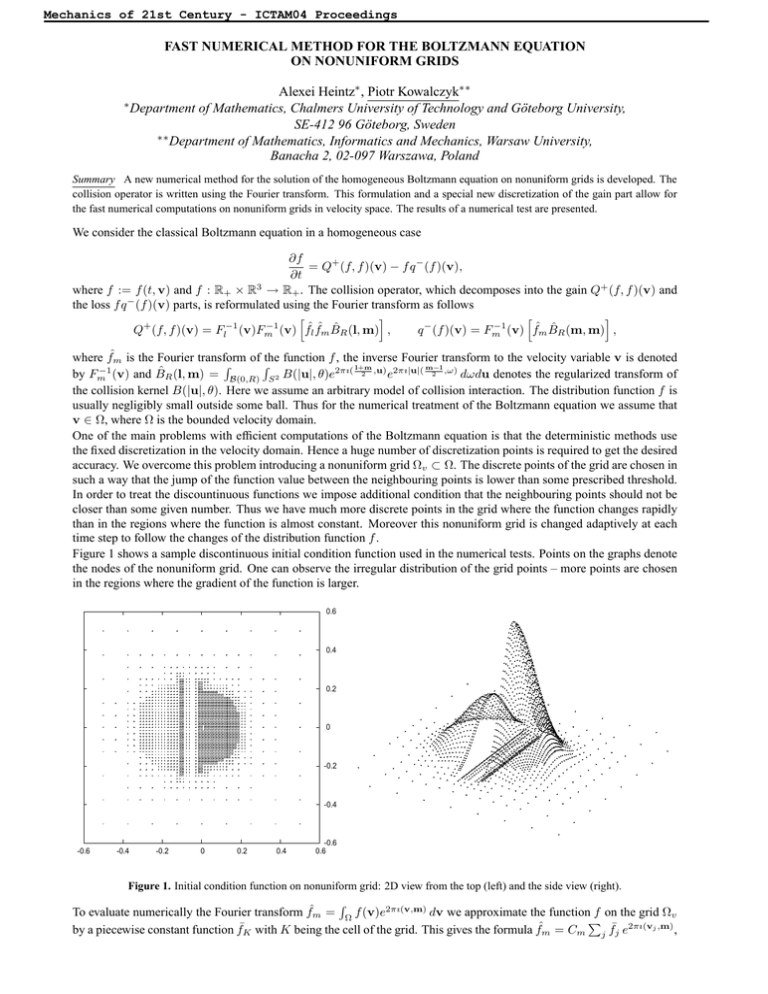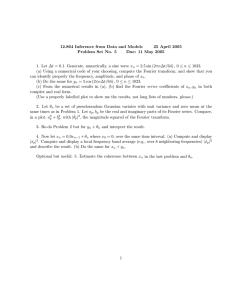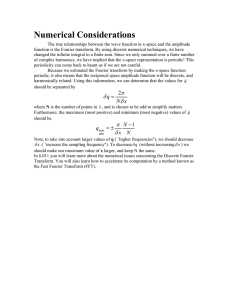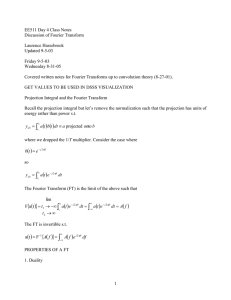FAST NUMERICAL METHOD FOR THE BOLTZMANN EQUATION ON NONUNIFORM GRIDS Alexei Heintz
advertisement

Mechanics of 21st Century - ICTAM04 Proceedings FAST NUMERICAL METHOD FOR THE BOLTZMANN EQUATION ON NONUNIFORM GRIDS Alexei Heintz∗ , Piotr Kowalczyk∗∗ of Mathematics, Chalmers University of Technology and Göteborg University, SE-412 96 Göteborg, Sweden ∗∗ Department of Mathematics, Informatics and Mechanics, Warsaw University, Banacha 2, 02-097 Warszawa, Poland ∗ Department Summary A new numerical method for the solution of the homogeneous Boltzmann equation on nonuniform grids is developed. The collision operator is written using the Fourier transform. This formulation and a special new discretization of the gain part allow for the fast numerical computations on nonuniform grids in velocity space. The results of a numerical test are presented. We consider the classical Boltzmann equation in a homogeneous case ∂f = Q+ (f, f )(v) − f q − (f )(v), ∂t where f := f (t, v) and f : R+ × R3 → R+ . The collision operator, which decomposes into the gain Q+ (f, f )(v) and the loss f q − (f )(v) parts, is reformulated using the Fourier transform as follows h i i h −1 −1 Q+ (f, f )(v) = Fl−1 (v)Fm (v) fˆm B̂R (m, m) , (v) fˆl fˆm B̂R (l, m) , q − (f )(v) = Fm where fˆm is the Fourier transform of the function f , the inverse Fourier transform to the velocity variable v is denoted R R l+m m−l −1 by Fm (v) and B̂R (l, m) = B(0,R) S 2 B(|u|, θ)e2πı( 2 ,u) e2πı|u|( 2 ,ω) dωdu denotes the regularized transform of the collision kernel B(|u|, θ). Here we assume an arbitrary model of collision interaction. The distribution function f is usually negligibly small outside some ball. Thus for the numerical treatment of the Boltzmann equation we assume that v ∈ Ω, where Ω is the bounded velocity domain. One of the main problems with efficient computations of the Boltzmann equation is that the deterministic methods use the fixed discretization in the velocity domain. Hence a huge number of discretization points is required to get the desired accuracy. We overcome this problem introducing a nonuniform grid Ωv ⊂ Ω. The discrete points of the grid are chosen in such a way that the jump of the function value between the neighbouring points is lower than some prescribed threshold. In order to treat the discountinuous functions we impose additional condition that the neighbouring points should not be closer than some given number. Thus we have much more discrete points in the grid where the function changes rapidly than in the regions where the function is almost constant. Moreover this nonuniform grid is changed adaptively at each time step to follow the changes of the distribution function f . Figure 1 shows a sample discontinuous initial condition function used in the numerical tests. Points on the graphs denote the nodes of the nonuniform grid. One can observe the irregular distribution of the grid points – more points are chosen in the regions where the gradient of the function is larger. 0.6 0.4 0.2 0 -0.2 -0.4 -0.6 -0.4 -0.2 0 0.2 0.4 -0.6 0.6 Figure 1. Initial condition function on nonuniform grid: 2D view from the top (left) and the side view (right). R To evaluate numerically the Fourier transform fˆm = Ω f (v)e2πı(v,m) dv we approximate the function f on the grid Ωv P by a piecewise constant function f¯K with K being the cell of the grid. This gives the formula fˆm = Cm j f¯j e2πı(vj ,m) , Mechanics of 21st Century - ICTAM04 Proceedings where f¯j is a value of the function f¯K in a discrete point vj ∈ Ωv and Cm is a constant. To compute this trigonometric sum we use the Unequally Spaced Fast Fourier Transform (USFFT) algorithm developed by Beylkin [1]. It is a variant of the standard Fast Fourier Transform especially suitable for nonuniform grids. The computational cost of this algorithm is O(Nv ) + O(M 3 log M ), where Nv is the number of discrete velocity points and M denotes the number of modes in the Fourier domain in one direction. The collision operator is splitted into two parts, thus we discretize independetly the gain and the loss parts to get Q+ (f, f )(v) = M −1 X fˆl fˆm B̂(l, m)e−2πı(l+m,v) , q − (f )(v) = M −1 X fˆm B̂(m, m)e−2πı(m,v) . m=−M l,m=−M To compute the loss part we apply straightforwardly the USFFT algorithm. To efficiently evaluate the gain part we separate variables l and m in the kernel B̂(l, m) using the eigenvalue decomposition. Then we approximate the kernel using only the significant eigenvalues. This greatly reduces the computational effort – due to the special properties of the kernel the number of significant eigenvalues is relatively small. Hence we get the following approximation to the gain term " M −1 #2 σ X X + −2πı(m,v) Q (f, f )(v) = dr fˆm Ur (m)e , p=1 m=−M which can be easily evaluated using USFFT algorithm. Here σ is the number of significant eigenvalues of the kernel matrix, which is typically 81 to 14 of the total number for the Maxwellian gas and hard spheres models, and Ur is the eigenvector corresponding to the eigenvalue dr . The total computational cost of the numerical approximation of the collision operator is O(Nv ) + O(σM 6 log M ). To justify the method we perform a number of numerical computations. Below we present the result of a sample test – the relaxation problem. We take the sum of two ”half”-Maxwellians as the initial function (see Figure 1). Figure 2 shows the 1D cut of the initial function (dashed line) and the relaxed numerical solution (continuous line). 90 80 70 60 50 40 30 20 10 0 -0.6 -0.4 -0.2 0 0.2 0.4 0.6 Figure 2. Relaxation problem; 1D cut at vy = 0, vz = 0. References [1] Beylkin G.: On the Fast Fourier Transform of Functions with Singularities, Appl. Comp. Harm. Anal., 2:363–381, 1995. << session << start






